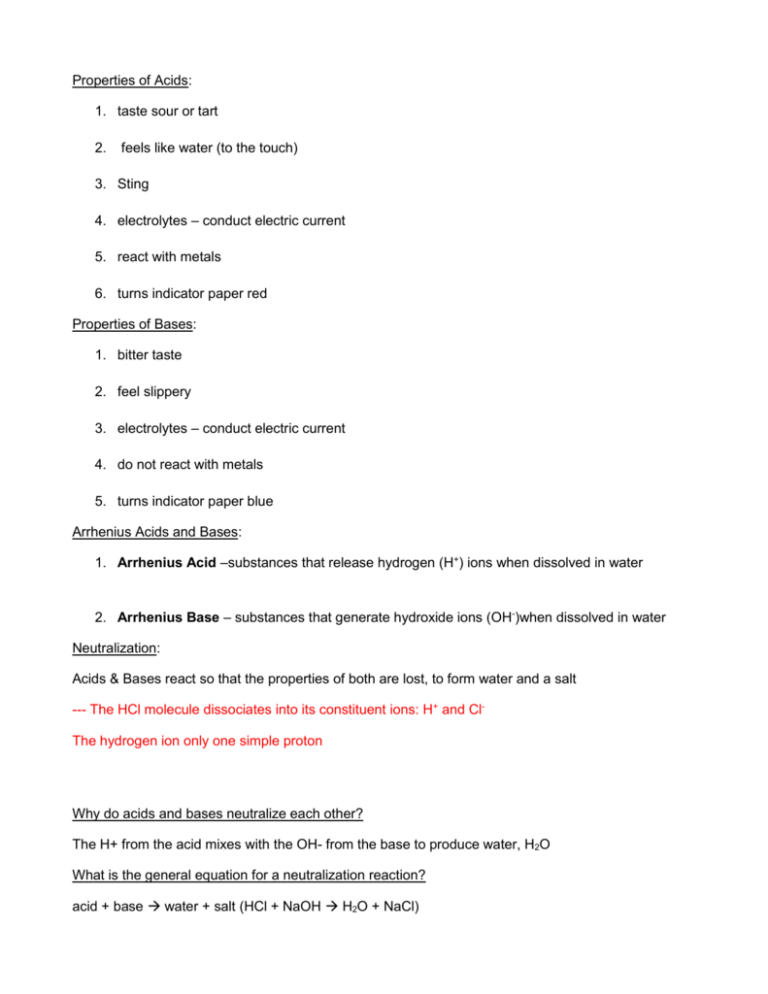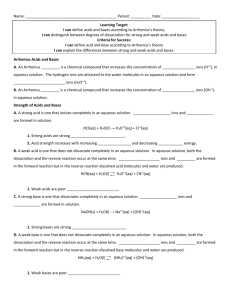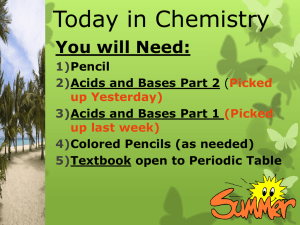Properties of Acids: taste sour or tart feels like water (to the touch
advertisement

Properties of Acids: 1. taste sour or tart 2. feels like water (to the touch) 3. Sting 4. electrolytes – conduct electric current 5. react with metals 6. turns indicator paper red Properties of Bases: 1. bitter taste 2. feel slippery 3. electrolytes – conduct electric current 4. do not react with metals 5. turns indicator paper blue Arrhenius Acids and Bases: 1. Arrhenius Acid –substances that release hydrogen (H+) ions when dissolved in water 2. Arrhenius Base – substances that generate hydroxide ions (OH-)when dissolved in water Neutralization: Acids & Bases react so that the properties of both are lost, to form water and a salt --- The HCl molecule dissociates into its constituent ions: H+ and ClThe hydrogen ion only one simple proton Why do acids and bases neutralize each other? The H+ from the acid mixes with the OH- from the base to produce water, H2O What is the general equation for a neutralization reaction? acid + base water + salt (HCl + NaOH H2O + NaCl) Brønsted-Lowry (B-L) Acids and Bases: 1. Name two things that were wrong with the Arrhenius definitions of acids and bases? - They could not explain why a number of products like baking soda (Na2CO3) acted like a base but contained no hydroxide (OH-) ions - Definitions are limited to reactions of acids and bases in water 2. Brønsted-Lowry Acids – any substance that can donate a hydrogen (H+) ion (aka: proton) 3. Brønsted-Lowry Bases – any substance that accepts a hydrogen (H+) ion (aka: proton) 4. This definition expands the number of substances that can be acids and bases and shows the 5. Under to the B-L definition, both acids and bases are related to the concentration of H+ ions (acids increase the concentration by donating protons ; bases decrease the concentration by accepting them) 6. Therefore, the acidity or basicity of something can be measured by the proton (H+ ion) concentration Strong vs. Weak 1. Strong acid – readily transfers H+ ions to water; the more complete the transfer of H+ ions, the stronger the acid Example: HCl – more than 99% of the H+ ions from HCl are transferred to water to form H3O+ ions 2. Weak acid – does not transfer/donate H+ ions as readily in water Example: vinegar, CH3COOH – only 0.4% of the H+ ions from CH3COOH are transferred to water; 99.6% does not dissociate 3. Strong base – substances which have the strongest attraction for H+ ions Example: Ca(OH)2 4. Weak base – only partially react with water/ partially attract H+ ions Conjugate Acids-Base Pairs Example: H+ and HCO3- (differ by only one proton) There is an inverse relationship between the strength of an acid and its conjugate base: the stronger the acid, the weaker its conjugate base (and vice versa) The pH Scale Water can act like and acid or a base: Acts like acid - H2O donates H+ to become OHActs like base – H2O accepts H+ to become H3O+ The amount of H3O+ ions in pure water is 10-7 moles/liter The pH scale is a the measurement of H3O+ ions in the solution What is the pH concentration range? 10-1 through 10-14 Where does the pH number come from? The exponent What is the pH of water? 7 All of the solutions that are lower than 7 are acids; all of the solutions higher than 7 are bases pH in the Chemistry of Nature Water can act like and acid or a base: 1. Agriculture – most plants prefer neutral soil, pH of farmer field is very important 2. Environment – Acid Rain – most rain water has a pH between 6-7; rainfall with a pH below 5.6 3. Health – pH of saliva, stomach acids, and blood (pH must be between 7.35 and 7:45) Buffers – in the human body in order to resist changes in pH Quiz: 1. True 6. Hydrogen ions 2. False 7. True 3. Neutralization 8. False 4. False 9. True 5. True 10. Acid Rain







